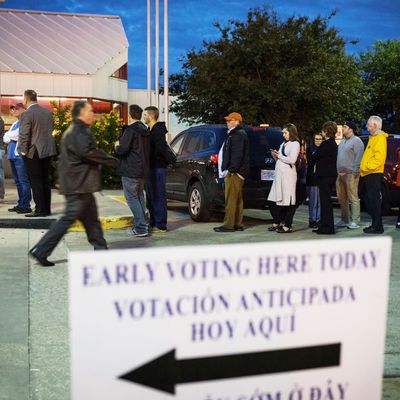
With early voting (either by mail or in person) now underway in 28 states as of today, the first numbers are coming in. And they are for the most part very impressive, as David Catanese reports:
[M]ore than 5 million people have already cast ballots in this year’s midterm general election, with a number of states experiencing record levels of early voting.
In Indiana, home to one of the most crucial U.S. Senate contests in the country, residents in centrally located Hamilton County are casting ballots at a rate equal to the 2016 presidential election. In Minnesota, which is hosting a trio of competitive U.S. House races, early voting statewide has thus far surpassed ballots returned in 2016.
And in Georgia, which is featuring one of the most competitive governor’s races of the year, ballots are being returned at three times the rate of the 2014 midterm.
In Houston, Texas, where an incredibly intense Senate race between Ted Cruz and Beto O’Rourke has fired up partisans on both sides, people could not wait to vote:
Thousands of people were already camped out at a key early voting location in Houston on Monday morning, hours before voting was even set to begin.
Nearly 2,000 people stood in line outside of the Metropolitan Multi-Service Center on West Gray near River Oaks in a scene that looked more like a Black Friday shopping morning.
America’s reigning early voting expert, Michael McDonald, thinks the early voting surge is indicative of what we will see when it’s all over:
“We’re going to have high turnout,” says Michael McDonald, a University of Florida political science professor who meticulously tracks the early vote. “You’d have to go back to the founding of the country to see presidential turnout rates during midterm elections. In some states, it’s possible, if the trajectory holds up.”
McDonald is forecasting a national turnout rate between 45 and 55 percent, which even at its low end would easily trample 2014’s abysmal showing of 37 percent, the worst turnout since 1942, partly due to a lack of competitive races at the top of the tickets in the largest states. The last midterm that nears his forecasted rate was in 1966, when 49 percent of the country’s eligible voters cast ballots.
Everything else being equal, high turnout in a midterm election would probably be seen as a good sign for Democrats, who rely on demographic groups (especially millennials and Latinos) who typically participate at very low levels in non-presidential elections. But it’s important to note that Republicans tend to do better in by-mail absentee voting, while Democrats usually show strength in in-person early voting, and the mix (and timing) of each in various states differs significantly. One quick analysis from NBC suggests Republicans are off to a faster start:
Republican-affiliated voters have outpaced Democratic-affiliated voters in early voting in seven closely watched states, according to data provided by TargetSmart and independently analyzed by the NBC News Data Analytics Lab.
GOP-affiliated voters have surpassed Democratic-affiliated ones in early voting in Arizona, Florida, Georgia, Indiana, Montana, Tennessee and Texas, the data showed.
Only in Nevada have Democratic-affiliated voters exceeded Republican-affiliated voters so far in early voting, according to the data.
As noted, in-person early voting has just begun in Texas, and is beginning at various points this week in Florida.
And in general, 2016 showed how misleading early voting patterns (and over-interpretation of them) can be, as Nate Silver observed in his elaborate postmortem on how so many people got the presidential results so wrong:
Historically, the relationship between early voting in a state and the final voting totals there has been weak, and attempts to make inferences from early voting data have made fools of otherwise smart people. In the 2014 midterms, Democrats used early-vote numbers to claim that the polls were underrating their chances. Instead, it was Republicans who substantially beat the polls …
In North Carolina, Clinton won the early vote by 2.5 percentage points, or about 78,000 votes. Furthermore, about two-thirds of votes were cast early. But Trump won the Election Day vote by almost 16 percentage points. That was enough to bring him a relatively healthy, 3.6-point margin of victory over Clinton overall.
Republicans won on election day in North Carolina by an even larger margin in 2012, winning a state where Obama won early voting by nearly five percent.
So it’s smart to assume elections aren’t over until they are over. But the intense interest in this midterm suggested by high levels of early voting could make the results especially dramatic.






























